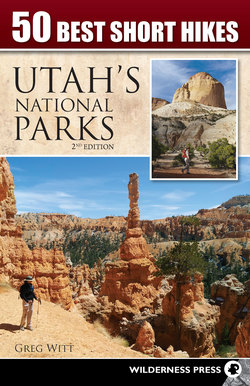Читать книгу 50 Best Short Hikes in Utah's National Parks - Greg Witt - Страница 19
На сайте Литреса книга снята с продажи.
Оглавление2 Balanced Rock
Trailhead Location: Balanced Rock Parking Area
Trail Use: Walking, hiking
Distance & Configuration: 0.5-mile balloon
Elevation Range: 5,042' at trailhead to 5,070' at the loop’s extension
Facilities: Vault toilet and picnic tables on Willow Flats Road, 0.2 mile north of trailhead
Highlights: A loop hike around one of the world’s most-visited and widely photographed balanced rocks
DESCRIPTION
You’ll see Balanced Rock in the distance and may even be tempted to drive right by as you head down the road in search of the more spectacular arches in the park. But this red-rock monolith is certainly worth a short stop, if for no other reason than to stretch your legs. In return you’ll be rewarded with an up-close 360-degree view of this natural wonder that seems to defy gravity. The short walk gives you a chance to become familiar with the natural forces that created the arches farther down the road.
The general term balanced rock or balancing rock can be applied to any geologic formation in which a large boulder appears to be balancing on top of a pedestal or base. In reality, they are firmly attached to the pedestal (for example, the Entrada Sandstone’s Dewey Bridge formation).
Balanced rocks are classified into different categories: glacial erratics, perched blocks, and erosional remnants. The balanced rock before you, along with the other balanced rocks and hoodoos throughout the Colorado Plateau, is clearly an erosional remnant, a formation of harder rock that remains after erosion has whittled away the softer material underneath in a process called differential erosion. In the process, the larger, more erosion-resistant layer on top now provides some protection to the softer layer on which it rests, thereby lengthening its precarious life.
While the centerpiece of this hike is Balanced Rock, don’t let the views of the La Sal Mountains in the southeast go unnoticed. The La Sals are Utah’s second-highest range, with its highest peak, Mount Peale, rising to 12,726 feet above sea level. The range’s name, meaning “salt,” was given by Spanish explorers, who may have doubted the existence of snowcapped desert peaks so far south. Instead, they believed the white summits were salt deposits, known to exist in the region.
ROUTE
From the parking area, the trail takes a direct route across desert brush to make a loop around Balanced Rock. The trail gently rises to a crest between Bubo Tower, a monolith fin and popular rock-climbing area to the immediate southeast of Balanced Rock. You’ve seen Balanced Rock from a mile or more in the distance and from the trailhead parking area, but there is simply no substitute for seeing it up close and making the full loop.
Standing below Balanced Rock presents a bit of an optical illusion, and it’s difficult to really comprehend its size. Is it larger than a school bus? Smaller than a house? The top of Balanced Rock is about 128 feet above the base where you are standing, and the rock itself is about 55 feet above the pedestal on which it sits. The rock is roughly the size of three school buses.
From the trail you’ll also see Elephant Butte to the southeast. Turret Arch and Double Arch, likely your next stop on your Arches visit, are visible to the right side of Elephant Butte, and the fanciful Parade of Elephants formation is south of Double Arch. If those views whet your appetite for some the park’s most wondrous arches, then return to the parking area to continue your adventure.
TO THE TRAILHEAD
GPS Coordinates: N38º 42.104' W109º 33.958'
From the Arches National Park entrance station, continue on Arches Scenic Drive (the main park road) for 8.7 miles to the Balanced Rock Parking Area, on your left.
Balanced Rock
DO BALANCED ROCKS AND ARCHES FALL?
These fragile erosional remnants were gradually carved to their current form by wind, water, and other natural factors. Because balanced rocks and arches are constantly being eroded away, they don’t last forever. Balanced Rock in Arches National Park once had a companion called Chip Off the Old Block, and it was also perfectly balanced until nature’s forces caused it to fall in the winter of 1975–76.
Rockfall occurs frequently in Arches National Park and is most likely to happen after heavy rains or on winter afternoons as the sun quickly warms the cold rocks. During the night of August 8, 2008, Wall Arch, the 12th-largest arch in the park, collapsed. Arches and balanced rocks will eventually defy the forces holding them in place and succumb to gravity.
